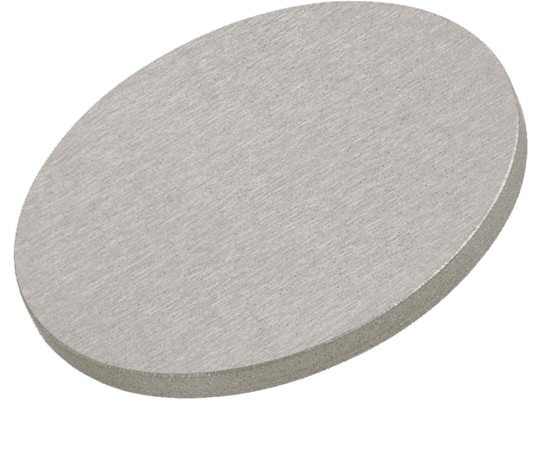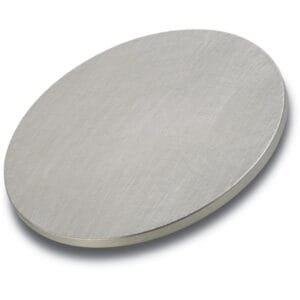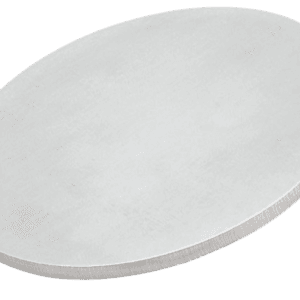Antimony Sulfide Sputtering Target Description
An antimony sulfide sputtering target is a type of ceramic sputtering material composed of antimony (Sb) and sulfur (S). This material is commonly used in various thin film deposition applications due to its specific properties. The target’s composition makes it suitable for creating films with unique electrical and optical characteristics, often utilized in the semiconductor industry, photovoltaic devices, and other advanced technological applications.
 Antimony is a lustrous gray metalloid found predominantly in nature as the sulfide mineral stibnite (Sb2S3). Historically, antimony compounds were utilized in medicine and cosmetics, commonly referred to as kohl in Arabic culture. The metallic form of antimony was known in ancient times but was often mistakenly identified as lead. The earliest detailed description of metallic antimony in Western literature dates back to 1540, written by Vannoccio Biringuccio. Industrially, antimony is refined through methods such as roasting and reduction with carbon, or by direct reduction of stibnite using iron.
Antimony is a lustrous gray metalloid found predominantly in nature as the sulfide mineral stibnite (Sb2S3). Historically, antimony compounds were utilized in medicine and cosmetics, commonly referred to as kohl in Arabic culture. The metallic form of antimony was known in ancient times but was often mistakenly identified as lead. The earliest detailed description of metallic antimony in Western literature dates back to 1540, written by Vannoccio Biringuccio. Industrially, antimony is refined through methods such as roasting and reduction with carbon, or by direct reduction of stibnite using iron.
Related Product: Antimony Sputtering Target
 Sulfur, also known as sulphur, is a chemical element whose name may originate from either the Sanskrit word ‘sulvere’ or the Latin ‘sulfurium,’ both referring to sulfur. It has been known and used since ancient times, with records of its use dating back to before 2000 BC, notably by the Chinese and Indians. The chemical symbol for sulfur is “S,” and it holds the atomic number 16 on the periodic table, located in Period 3 and Group 16, part of the p-block. The relative atomic mass of sulfur is 32.065(5) Dalton, with the number in parentheses indicating the uncertainty of the measurement.
Sulfur, also known as sulphur, is a chemical element whose name may originate from either the Sanskrit word ‘sulvere’ or the Latin ‘sulfurium,’ both referring to sulfur. It has been known and used since ancient times, with records of its use dating back to before 2000 BC, notably by the Chinese and Indians. The chemical symbol for sulfur is “S,” and it holds the atomic number 16 on the periodic table, located in Period 3 and Group 16, part of the p-block. The relative atomic mass of sulfur is 32.065(5) Dalton, with the number in parentheses indicating the uncertainty of the measurement.
Antimony Sulfide Sputtering Target Specification
| Compound Formula | Sb2S3 |
| Appearance | Gray, Crystalline Solid |
| Density | 4.12 g/cc |
| Melting Point | 550℃ |
| Type of Bond | Indium, Elastomer |
| Available Sizes | Dia.: 1.0″, 2.0″, 3.0″, 4.0″, 5.0″, 6.0″ Thick: 0.125″, 0.250″ |
Antimony Sulfide Sputtering Target Application
The antimony sulfide sputtering target is used for thin film deposition, decoration, semiconductor, display, LED and photovoltaic devices, functional coating as nicely as other optical information storage space industry, glass coating industry like car glass and architectural glass, optical communication, etc.
Antimony Sulfide Sputtering Target Packing
Our antimony sulfide sputter targets are meticulously tagged and labeled externally to guarantee efficient identification and quality control. We take great care during storage and transportation to prevent any potential damage, ensuring that the products arrive in excellent condition.
Get Contact
TFM offers antimony sulfide Sputtering Targets in various forms, purities, sizes, and prices. We specialize in high-purity thin film deposition materials with optimal density and minimal grain sizes, which are ideal for semiconductor, CVD, and PVD applications in display and optics. Contact Us for current pricing on sputtering targets and other deposition materials that are not listed.


 MSDS File
MSDS File



Reviews
There are no reviews yet.